The next-gen MacBook Pro with Retina Display Review
by Anand Lal Shimpi on June 23, 2012 4:14 AM EST- Posted in
- Mac
- Apple
- MacBook Pro
- Laptops
- Notebooks
GPU Performance
We’ve already established that NVIDIA’s Kepler architecture is fast, but the GeForce GT 650M used in the rMBP is hardly the best NVIDIA has to offer. The result however is a significant improvement in performance over the Radeon HD 6750M used in the previous generation model.
| 15-inch MacBook Pro Model | Mid 2010 | Upgraded Early 2011 | Upgraded Late 2011 | Retina |
| GPU | GeForce GT 330M | Radeon HD 6750M | Radeon HD 6770M | GeForce GT 650M |
| Cores | 48 | 480 | 480 | 384 |
| Core Clock | 500MHz | 600MHz | 675MHz | 900MHz |
| Memory Bus | 128-bit GDDR3 | 128-bit GDDR5 | 128-bit GDDR5 | 128-bit GDDR5 |
| Memory Data Rate | 1580MHz | 3200MHz | 3200MHz | 5016MHz |
| Memory Size | 512MB | 1GB | 1GB | 1GB |
The GT 650M offers fewer “cores” compared to the 6750M and 6770M used in previous MacBook Pros, but likely better utilization of the available hardware. NVIDIA also clocks the cores much higher in the 650M, the result is a ~20% increase in theoretical raw compute power.
The memory bandwidth story is also better on Kepler. While both the GT 650M and the 67xxM feature a 128-bit GDDR5 interface, Apple clocked AMD’s memory interface at 800MHz compared to 1254MHz on Kepler. The resulting difference is 80.3GB/s of memory bandwidth vs. 51.2GB/s.
The real world impact is most noticeable at higher resolutions, thanks to the tremendous amount of memory bandwidth now available. The other benefit from the new GPU is obviously things run a lot cooler, which as I’ve already shown to considerably reduce thermal throttling under load.
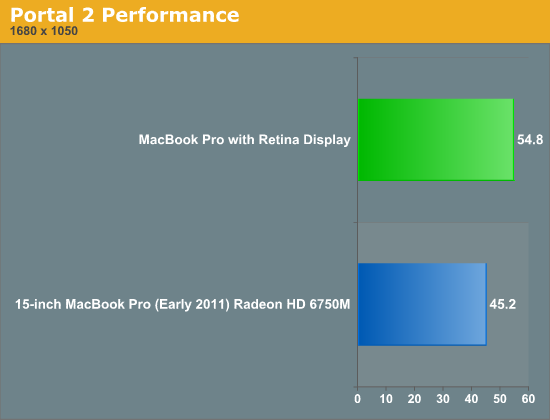
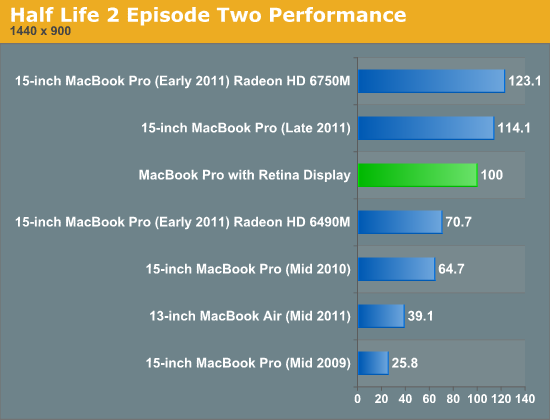
At 1440 x 900 we actually see a regression compared to the 2011 models, but differences in the AMD and NVIDIA GPU drivers alone can account for the difference at this hardly GPU bound setting. Look at what happens once we crank up the resolution:
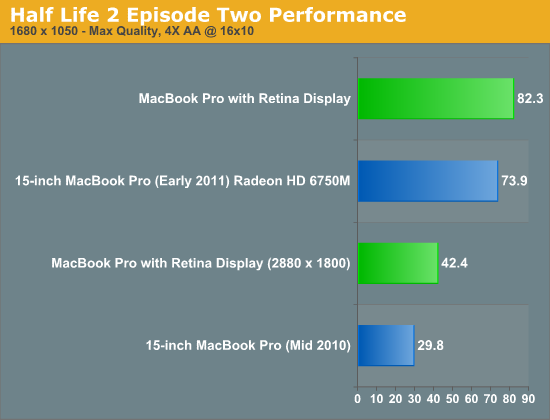
At 1680 x 1050 with 4X AA enabled we see a modest 11% increase in performance over last year's MacBook Pro. As I established earlier however, the rMBP will be able to more consistently deliver this performance over an extended period of time.
What's even more impressive is the 42.4 fps the GT 650M is able to deliver at the rMBP's native 2880 x 1800 resolution. Even though I ran the test with AA enabled I'm pretty sure AA was automatically disabled. At 2880 x 1800 the rMBP is able to outperform the two year old MacBook Pro running at 1680 x 1050. How's that for progress?
While the gains we've shown thus far have been modest at best, Starcraft 2 is a completely different story. Here for whatever reason the IVB + Kepler combination can be up to 2x the speed of last year’s models. I reran the tests both on the older and rMBP hardware to confirm, but the results were repeatable. The best explanation I have is Starcraft 2 is very stressful on both the CPU and GPU, so we could be seeing some thermal throttling on the older SNB + Turks hardware here.
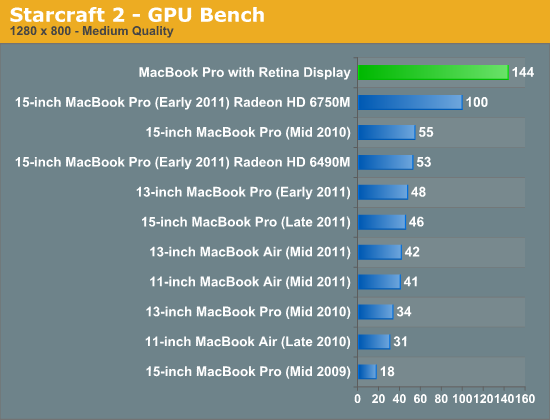
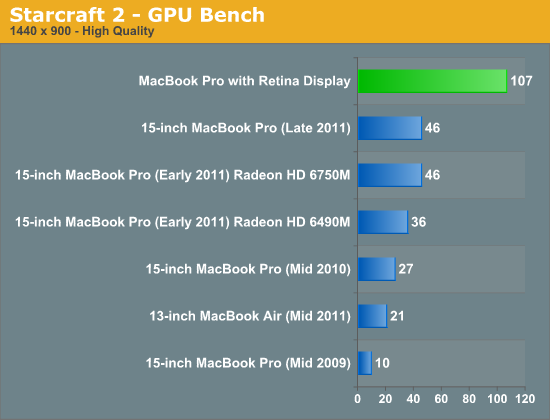
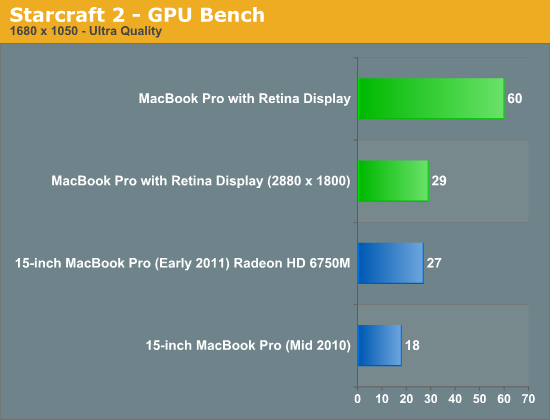
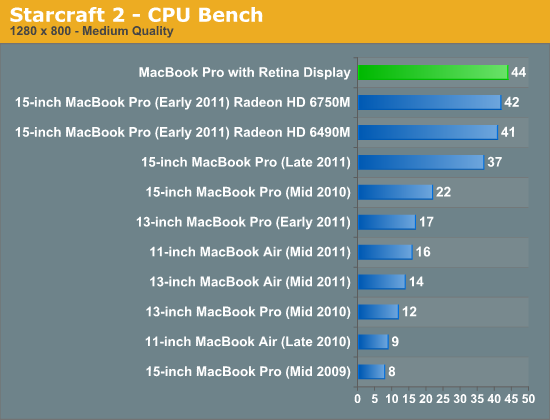
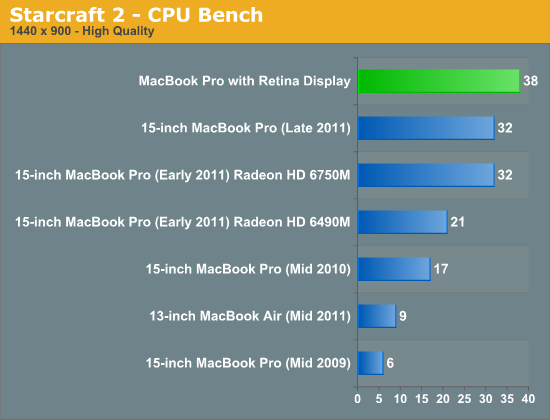

Once again we see playable, although not entirely smooth frame rates at 2880 x 1800. I've also included a screenshot of SC2 at 2880 x 1800 below:
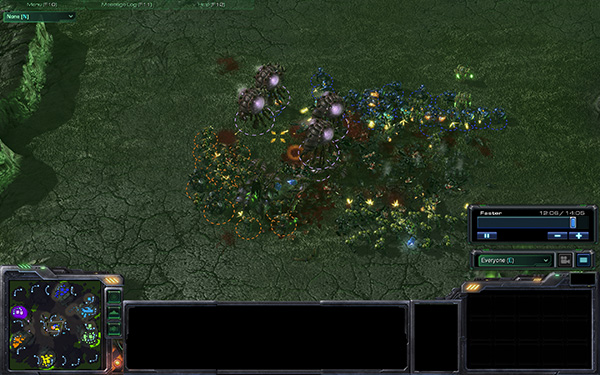
Starcraft 2 at 2880 x 1800, it's playable
Although gaming options continue to be limited under OS X, Diablo 3 is available and finally performs well on the platform thanks to the latest patches. Diablo 3 performance is appreciably better on the GT 650M compared to last year’s 6750M. There’s no FRAPS equivalent under OS X (free advertising to the first eager dev to correct that) so I have to rely on general discussion of performance here. The GT 650M is fast enough to drive the rMBP’s 2880 x 1800 panel at native resolution at playable frame rates, around 18 fps on average. Connected to an external 2560 x 1440 display however the GT 650M is fast enough to deliver around 30 fps in Diablo 3. For what it’s worth, performance under Diablo 3 is far more consistent with the rMBP than with last year’s MacBook Pro. I suspect once again we’re seeing the effects of thermal throttling under heavy CPU/GPU load that has been well mitigated by the move to more power efficient silicon.



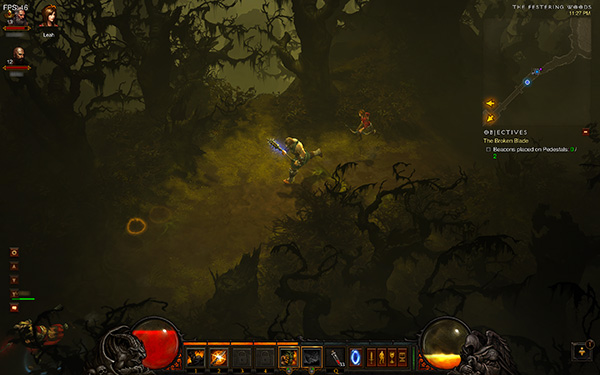








471 Comments
View All Comments
Super56K - Saturday, June 23, 2012 - link
Maybe talking paper specs on the software side it's 'the same' but really that's not even close. Dpi scaling is flaky in Windows anyways.And it's really not the same. It's rendered at double the resolution on a screen that actually has 4x's the pixels at the native 1440x900 res. Nobody else does that. Hell, it's rare to even find a 16:10 Windows laptop.
I don't own a MacBook anything, but some of you sound ridiculous in here going on about Sony laptops with 1080p screens
Spunjji - Tuesday, June 26, 2012 - link
What if I, the user, don't want my laptop rendering the display at a pointlessly high resolution just to scale it back down again? I understand the theory but the execution is utterly ridiculous.UpSpin - Saturday, June 23, 2012 - link
You're right, it wouldn't sell, because the issue is that Windows DPI scaling doesn't work so well. It also doesn't work perfectly in Mac OS (Chrome best example, they had to update it). And so will many older programs, which don't receive further updates, like Adobe Creative Suite <6 don't scale right (assumption)That's one reason that Apple released only one MacBook with a retina display, because the software isn't ready for DPI scaling yet. Apple was brave enough to do the step and force programers to integrate scaling in high res images in their programs because future MacBooks will have retina displays only.
No PC manuafcturer could have done such a step, they would have been blocked by the lack of proper scaling of Windows, rendering a high res display useless because of display errors. So Microsoft should have made Windows 7 resolution independent (just as all mobile OS are, which rely on DPI instead of absolute pixels), then PC manufacturers could have included high res displays which the customer could have used.
EnzoFX - Saturday, June 23, 2012 - link
MS Should have with Win7? Hardly. That was too long ago and there were no retina screens yet. Even 1080p screens were scarce. Remember that 99% were getting 1366x768 in their laptops.You're right in that Apple can sort of force developers to update apps for support. I do give them credit for usually implementing a solid stopgap. Their scaling for older apps is usually good enough without it being a bad experience. Forcing them to update is a good thing though, having that ecosystem of active developers is good. It's further easier on them to target simple hardware configurations. The benefits of vertical integration at its best. Now for these retina displays to trickle down to all their displays =P.
ananduser - Saturday, June 23, 2012 - link
Win7 scales perfectly well for a screen this res. Such an absurd panel jump however is meant as bragging rights. It also serves as differentiation. Instead of going "post PC" like W8 transformer devices at Computex, it adds a huge panel. There's nothing special about the hardware that hasn't been done before, except the impressive panel.Ohhmaagawd - Saturday, June 23, 2012 - link
Exactly what would constitute "special"?dagamer34 - Sunday, June 24, 2012 - link
Mobile operating systems aren't resolution independent. The iPhone supports 2 resolutions, Windows Phone currently supports 1 resolution, but will support 3 in WP8, and Android supports a variety of resolutions, but is NOT resolution independent.garcondebanane - Saturday, June 23, 2012 - link
Frankly, yes I think so. See "the software side of retina" and "Achieving retina".I don't think any other PC manufacturer can realistically be expected to do it this seamlessly.
UberApfel - Saturday, June 23, 2012 - link
Apple didn't think of the idea. The screens are simply now available and Apple has the resources and reason to push it to market first. Apple also has their own operating system and software engineers to prepare for such.Anyone familiar with the market knows that Microsoft is a big kid nurtured by monopoly and ripping off corporations. The 'big game-changing release & failure' every few years just doesn't allow manufacturers to be first-adopters. Only OSX stays up-to-date, and only Apple may use OSX thanks to either IP or special-order hardware.
If Asus, Acer, or Toshiba were to shell out the cash to get a portion of the first batch and mass-produce some laptops w/ "retina display"; they'd just have a deficit. Apple is a designer; not a innovator. Anyone who makes that mistake is a fool.
MrSpadge - Monday, June 25, 2012 - link
It's not only about thinking about it, it's about building it and reaching out to make people buy it. It's hard to do this without the "Apple hype", no matter how good and innovative the product may be.